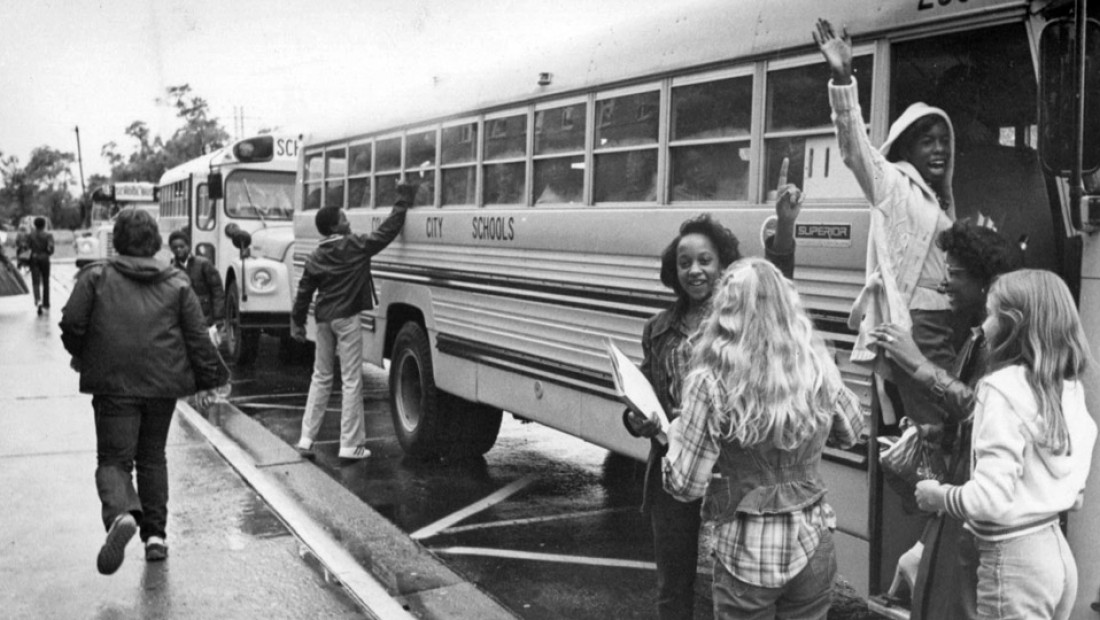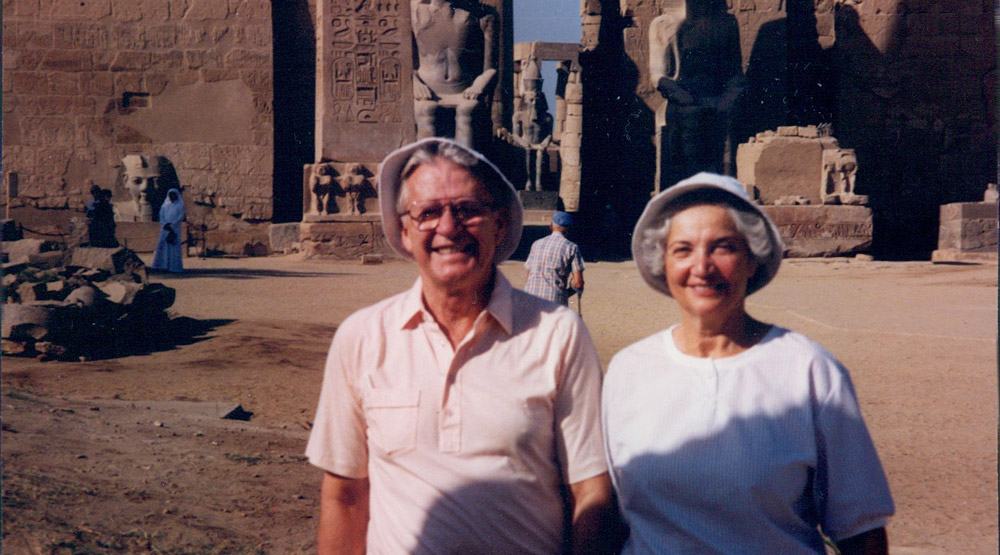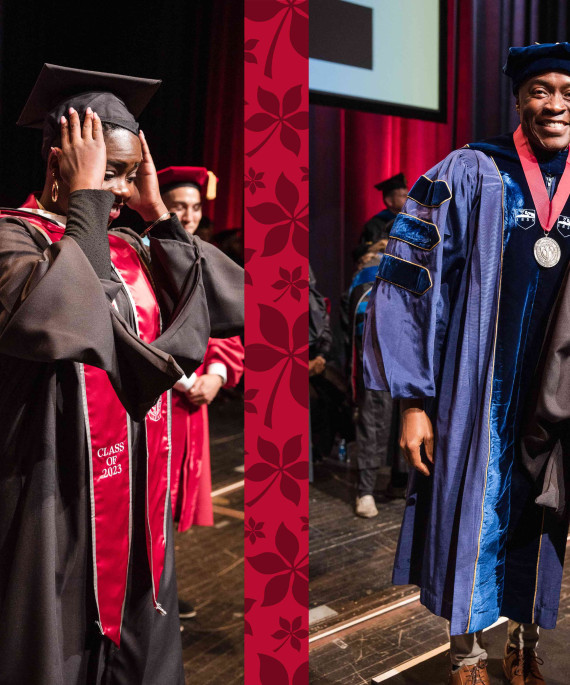
Students get into school buses at Buckeye Junior High, Columbus City Schools, on October 8, 1979. Photo by the Columbus Dispatch.
Luvern L. Cunningham had a sense of humor and a unique ability to draw on people’s strengths. As dean of the College of Education at The Ohio State University, he used both to pull together groups in conflict and guide them through problem solving.

During the period that he was dean, “The College of Education was the most exciting place in (such) colleges across the country,” said Faculty Emeritus Virgil Blanke. “It was at the forefront of a lot of new ideas … and was considered number one in almost all fields.”
Aware of Cunningham’s reputation, the Detroit Public Schools called on him in 1973 to lead their extensive school improvement efforts. No sooner had he finished working to improve lives for children and families in that city than the San Francisco Public Schools asked him to guide their desegregation efforts.
To accept the offers, which he did, Cunningham resigned the Ohio State deanship. Some would have considered this a drastic step, yet he valued the experience too much to turn it down. He kept his university ties as a tenured professor, with the cities paying Ohio State to retain him.
Cunningham spent five years leading these massive reform initiatives. “What it (the Detroit experience) meant for me,” he said in an oral history recorded in 2001, “is that I was acquiring insights into the problems and potential solutions that I would never have gotten sitting at a desk in Ramseyer Hall.”
The best-known case: Columbus Schools desegregation
Insights, indeed. Word spread about Cunningham’s low-key but significant role in Detroit and San Francisco and his ability to bring together citizens, school administrators and business people to craft school improvement projects benefiting all children.
In 1977, Cunningham was named the special master-commissioner to manage the desegregation of Columbus Public Schools. He worked closely with First Federal District Court Judge Robert M. Duncan, ’48 BS Education, ’52 JD, who decided the case.
“The two developed a warm and respectful companionship of like minds,” said Lila Carol Cunningham, Cunningham’s wife. “As they pondered the complex questions of the school district, their priority always was to find ways of working with both sides to address humane and practical concerns of the children and adults of the community.”

During this time, Cunningham was named the Novice G. Fawcett Professor of Educational Administration at Ohio State. The endowed fund was created to honor Fawcett, superintendent of Columbus Schools, then president of Ohio State. The appointment included funding to engage graduate students in Cunningham’s work.
Simultaneously, Detroit asked Cunningham to testify on their public schools’ decentralization in relation to desegregation. Cleveland also asked him to be an expert witness in its desegregation case.
“I suddenly found myself working in three different places with different aspects of desegregation litigation,” he said. “I learned an enormous amount about the law … and how it works.”
His involvement in the Columbus case was not the first with the district. He chaired a school improvement initiative early in his deanship in the late 1960s – the University Advisory Committee on Problems Facing Columbus Public Schools.
Cunningham was commissioned by President Fawcett, at the request of Columbus School Board, to conduct an external review of school climate focused on race and inequitable distribution of resources. The school board implemented 50 of the Cunningham committee’s recommendations.
In the 1977 case, the schools began to see some attractive gains in math and science among minority children, Cunningham said. He also regularly measured attitudes toward minorities among both teachers and students. “We saw some dramatic changes of more respect between and among students for one another,” he said in his oral history.
Work on the case lasted about seven years. Cunningham also worked on desegregation cases for St. Louis Public Schools, Rockford (Illinois) Public Schools and Cleveland Public Schools. By then, he had gained a national reputation for his expertise.

An innovative problem-solving process
As his work progressed and matured, “Vern recognized the urgent need to strengthen the influence of education by bringing together professionals from multiple points of view,” Lila Cunningham said.
In the early 1970s, Cunningham joined three prominent Columbus-area colleagues – an MD, a theologian and a lawyer – to form what eventually was called the Interprofessional Commission of Ohio. A 1974 grant from the Ohio Board of Regents formally launched the initiative.
The commission initially offered innovative, team-taught, credit and continuing education courses, taken by thousands of students and practitioners over the years. The goal was to support clinical cooperation on important topics — not a standard practice then — among professionals in allied medicine, education, law, medicine, nursing, psychology, social work and theology.
The group also conducted public policy panels that Cunningham influenced from the beginning. “He believed that for effective problem solving, all sectors of society must be represented,” said Faculty Emeritus R. Michael Casto, who served as associate director, then director of the commission from 1987 to 2001. “Vern used this collaborative approach in Detroit, St. Louis and other communities when he was drawing citizens together to work on desegregation.”
For the Detroit project, for instance, Cunningham assembled 16 representatives from across the university, two for each of the eight sectors of society indicated by Yale Professor Harold D. Lasswell in the 1968 journal International Society Science.
The representatives first identified their sector’s stake in the well-being of the community before moving on to problem solving. The sectors were: Power (government, courts, unions), Affection (families, family-supporting agencies, social work), Skills (public and non-public K-12 schools), Enlightenment (higher education, research organizations, libraries, media and museums), Wealth (land owners, banking, business/industry, insurance companies, foundations), Well-Being (health organizations, security, public safety, environmental groups), Respect (civil rights groups, voluntary associations), Rectitude (religious groups and organizations concerned with ethical behavior).

Coincidentally, Lasswell had an Ohio State appointment at this time. So as Cunningham put the experts’ concepts into action, Lasswell attended the meetings. He would sit in the corner and never say a word as Cunningham presented data and updates from the Detroit project. The 12 representatives would ask questions; important selections from the discussion would be recorded.
Even if they called upon him, as they did, Lasswell would say, “Well, let’s just wait and we’ll see how this goes,” Cunningham said in his oral history.
But at the end, Lasswell would “lay it all out in just a few paragraphs, and things that were muddled would become clear,” Cunningham said. “(He had an) enormous capacity of synthesis.”
Of all his achievements, Cunningham said in October, prior to his December 6, 2019, passing, he was most proud of co-founding the commission.
“To me, bringing these helping professionals together was a profound achievement,” he said. “Their discussions were monumental because it was so unusual for these groups to get together with the objective of solving problems.”
One of these sessions focused on the needs of Weinland Park, a neighborhood southeast of the university that is federally designated as low income. As a result, citizens asked the city to create the University Area Commission, which, among many things, began to engage people at the university with its neighbors.
Over the years, many university and community projects took place, especially in the 1990s and early 2000s. From service-learning courses in the neighborhood for Ohio State students, to seed grant projects directed by faculty from 14 of the university’s colleges, to courses in the building trades to provide skills for unemployed neighborhood residents.
Again, the overall goal was to provide neighbors with the tools to improve their lives.
A love of education to last a lifetime
Cunningham remained active with the commission until 2005. “He really built the intellectual base for interprofessional education,” Casto said. “Ohio State provided the model and experience for other communities and institutions to develop programs in interprofessional education and practice.”
Under Cunningham’s leadership, national professional associations and accrediting bodies gathered for several meetings in the late 1980s as the National Consortium on Interprofessional Education and Practice. By 1998, over 75 colleges and universities in the United States had programs of interprofessional collaboration, many influenced by Ohio State’s and Cunningham’s work.
Cunningham retired from Ohio State in 1989 but didn’t retire from service to education until recent years. He is known for his leading textbook in school administration, the first of its kind, that went into six editions, in addition to his many other publications.
Cunningham and his wife, Lila Carol Cunningham, started Leadership Development Associates after he retired from his professorship. In great demand, they conducted field studies, leadership preparation and school board development as well as consulted on challenging problems. The legislatures in Ohio and Kentucky called on them for support on education issues.
During the early 1990s, Cunningham also was monitor-commissioner over the school board of the Texas Education Agency and superintendent during an 18-month transition. In 1999, he was professor of educational administration at the University of Akron.
“Throughout his life, Vern consistently demonstrated the relatively low cost of being human, kind and caring, even as he rejected the high price of arrogance, greed and perfidy,” Casto said. “He was a beacon for celebrating these values with all people and in all that he did.”
Part 1: How Cunningham gained his experience, problem-solver reputation
To support Cunningham's legacy in the college and suport students studying educational administration, donate to the Luvern L. and Lila Carol Cunningham Governance of Educational Studies Fund.




